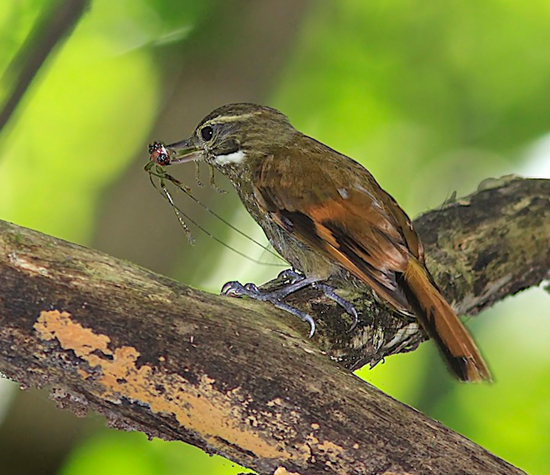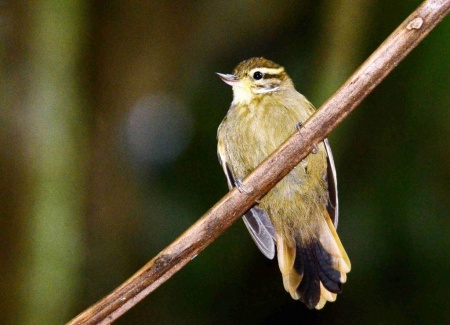- Xenops minutus
Identification
11–12 cm (4¼-4¾ in)
- Light brown head
- Buff supercilium
- Whitish malar stripe.
- Brown upperparts
- Rufous tail and rump
- Buff bar on the darker brown wings
- Olive-brown unstreaked underparts
The sexes are similar, but young birds have dark brown throats
Similar species
Where overlapping, Streaked Xenops is usually found at higher elevation than Plain Xenops. Also check other members of the genus Xenops.
Distribution
Central America and South America
Central America: From Southern Mexico through Panama.
South America: west of the Andes in Ecuador and Colombia, and in northern Colombia connected with the large area east of the Andes where the species is found south to Bolivia and Brazilian Amazon. A separate population is found in the Atlantic Forest part of Brazil to Paraguay and northeastern Argentina.
Taxonomy
It is a member of the South American bird family Furnariidae, a group in which many species build elaborate clay nests, giving rise to the English name for the family of "ovenbirds".
Subspecies
Eleven subspecies are recognized[1]:
- X. m. mexicanus: Tropical southern Mexico to Honduras
- X. m. ridgwayi: Tropical Nicaragua to Costa Rica and western Panama
- X. m. littoralis: Tropical eastern Panama to western Ecuador (El Oro)
- X. m. neglectus: North Colombia and northern Venezuela
- X. m. olivaceus: Lowlands of north-eastern Colombia
- X. m. remoratus: Tropical eastern Colombia to southern Venezuela and northern Brazil
- X. m. ruficaudus: Extreme eastern Colombia to Venezuela, the Guianas and northern Brazil
- X. m. obsoletus: Tropical eastern Ecuador to eastern Peru, northern Bolivia and western Brazil
- X. m. genibarbis: North Brazil south of the Amazon (Rio Madeira to Maranhão)
- X. m. alagoanus: north-eastern Brazil (Paraíba, Pernambuco, and Alagoas)
- X. m. minutus: eastern Brazil (north to southern Bahia) to eastern Paraguay and north-eastern Argentina
Habitat
Wet tropical primary and secondary forests, usually below 1000 m asl but occasionally as high as 1800 m.
Behaviour
Breeding
The nest is made of shredded plant fibres placed in a hole between 1.5 and 9 m high in a decaying tree trunk or branch. The clutch contains 2 white eggs which are incubated by both sexes.
Diet
Diet consists of insect eggs, termites, katydids, spiders, ants and their larvae,
References
- Clements, J. F., T. S. Schulenberg, M. J. Iliff, D. Roberson, T. A. Fredericks, B. L. Sullivan, and C. L. Wood. 2017. The eBird/Clements checklist of birds of the world: v2017, with updates to August 2017. Downloaded from http://www.birds.cornell.edu/clementschecklist/download/
- Ridgely and Tudor 2009. Field guide to the songbirds of South America - The Passerines. University of Texas Press. ISBN 978-0-292-71979-8
- Restall et al. 2006. Birds of Northern South America. Yale University Press. ISBN 9780300124156
- Ber van Perlo. 2009. A field guide to the Birds of Brazil. Oxford University Press, New York, NY, USA. ISBN 978-0-19-530155-7
- Wikipedia
- BF Member observations
- Angehr and Dean 2010. The birds of Panama, a field guide
- Neotropical birds online quesried July 2018
Recommended Citation
- BirdForum Opus contributors. (2024) Plain Xenops. In: BirdForum, the forum for wild birds and birding. Retrieved 12 November 2024 from https://www.birdforum.net/opus/Plain_Xenops





